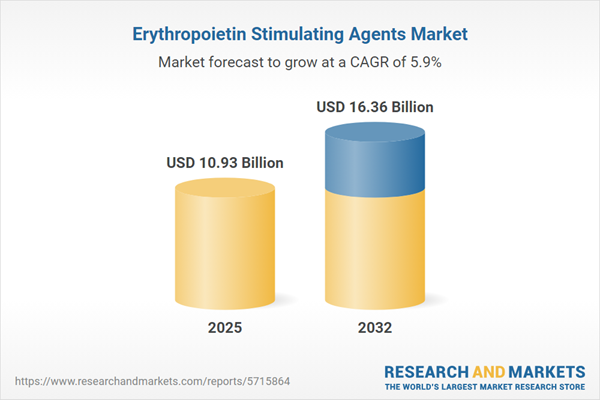Speak directly to the analyst to clarify any post sales queries you may have.
Senior healthcare leaders navigating evidence-based therapeutics will benefit from this comprehensive market analysis of erythropoietin stimulating agents, which explores strategic opportunities, regulatory drivers, and the evolving clinical landscape critical for informed decision-making across global healthcare systems.
Market Snapshot: Erythropoietin Stimulating Agents
The erythropoietin stimulating agents market demonstrates steady expansion, marked by a strong growth rate and increasing adoption across clinical settings. This trajectory reflects a shift toward advanced biologic therapies addressing anemia in varied patient populations, backed by improvements in product formulations, distribution channels, and reimbursement frameworks.
Scope & Segmentation
Gain actionable insights across key dimensions of the erythropoietin stimulating agents market, structured for senior executives seeking a comprehensive view of opportunities and risks:
- Product Types: Darbepoetin Alfa, Epoetin Alfa, Methoxy Polyethylene Glycol-Epoetin Beta.
- Indications: Chemotherapy-Induced Anemia, Renal Anemia.
- Routes of Administration: Intravenous Injection, Subcutaneous Injection.
- Distribution Channels: Hospital Pharmacy (Private, Public), Online Pharmacy, Retail Pharmacy (Chain, Independent).
- End Users: Clinics, Home Care Providers, Private Hospitals, Public Hospitals.
- Geographies: Americas (North America, Latin America), Europe, Middle East & Africa (Europe, Middle East, Africa), Asia-Pacific (China, India, Japan, Australia, South Korea, Indonesia, Thailand, Malaysia, Singapore, Taiwan).
- Key Companies: Amgen Inc., F. Hoffmann-La Roche Ltd, Johnson & Johnson, Pfizer Inc., Novo Nordisk A/S, Sandoz International GmbH, Teva Pharmaceutical Industries Ltd., Fresenius Kabi AG, Biocon Limited, Kyowa Kirin Co., Ltd.
Key Takeaways: Strategic Insights for Senior Decision-Makers
- Biosimilar launches and regulatory agility are reshaping market competition, presenting cost containment and access advantages for healthcare providers and payers.
- Innovations in molecular engineering extend dosing intervals and facilitate improved patient adherence, underpinning the transition toward long-acting therapies.
- Digital health platforms enable algorithm-driven dosing and real-world patient monitoring, supporting tailored treatment adjustments and better safety outcomes.
- Growth in emerging Asian and Latin American markets is accelerated by local manufacturing initiatives, enhanced reimbursement pathways, and higher diagnosis rates.
- Collaborative models between biopharma, healthcare systems, and academic centers are driving portfolio diversification and innovation pipelines across established and emerging therapeutic pathways.
- Segmentation analysis reveals nuanced utilization trends based on clinical indication, administration preference, care setting, and regional market dynamics.
Tariff Impact: Navigating U.S. Trade Measures in 2025
Recent U.S. tariff policies have increased input costs and prompted manufacturers to reconfigure supply chains. Many companies are establishing alternative procurement and production hubs to offset new expenses, while engaging in negotiations with contract manufacturing partners and healthcare providers to maintain product availability and minimize disruptions. Inventory and procurement practices are adapting rapidly, driving a focus on supply chain resilience and regional diversification.
Methodology & Data Sources
This analysis employs a mixed-method research approach combining in-depth primary interviews with clinicians, formulary managers, and payers, alongside systematic reviews of peer-reviewed publications, regulatory updates, and clinical trial data. Triangulation of qualitative and quantitative insights supports data integrity and relevance for strategic planning.
Why This Report Matters
- Enables executive teams to forecast risks and opportunities by leveraging up-to-date insights on evolving regulatory and technology landscapes in erythropoietin stimulating agents.
- Provides a clear framework for assessing market entry strategies, optimizing portfolios, and implementing value-based care initiatives across diverse geographical regions.
- Empowers decision-makers to align commercialization, sourcing, and patient engagement strategies amidst dynamic policy, tariff, and innovation trends.
Conclusion
The erythropoietin stimulating agents market continues to evolve, shaped by advances in biosimilars, responsive regulatory frameworks, and collaborative innovation. Strategic alignment with these transformative trends is vital for leadership aiming to enhance operational resilience and improve patient outcomes.
Additional Product Information:
- Purchase of this report includes 1 year online access with quarterly updates.
- This report can be updated on request. Please contact our Customer Experience team using the Ask a Question widget on our website.
Table of Contents
3. Executive Summary
4. Market Overview
7. Cumulative Impact of Artificial Intelligence 2025
Companies Mentioned
The companies profiled in this Erythropoietin Stimulating Agents market report include:- Amgen Inc.
- F. Hoffmann-La Roche Ltd
- Johnson & Johnson
- Pfizer Inc.
- Novo Nordisk A/S
- Sandoz International GmbH
- Teva Pharmaceutical Industries Ltd.
- Fresenius Kabi AG
- Biocon Limited
- Kyowa Kirin Co., Ltd.
Table Information
| Report Attribute | Details |
|---|---|
| No. of Pages | 196 |
| Published | November 2025 |
| Forecast Period | 2025 - 2032 |
| Estimated Market Value ( USD | $ 10.93 Billion |
| Forecasted Market Value ( USD | $ 16.36 Billion |
| Compound Annual Growth Rate | 5.9% |
| Regions Covered | Global |
| No. of Companies Mentioned | 11 |









